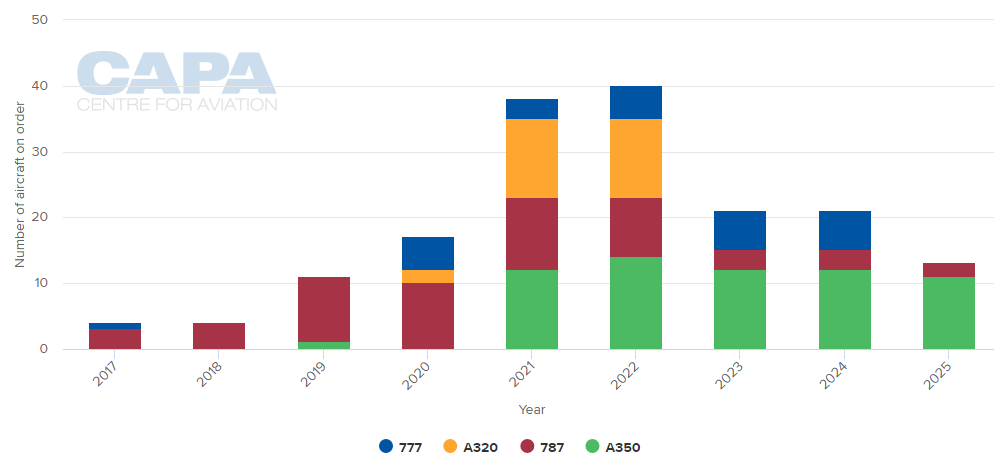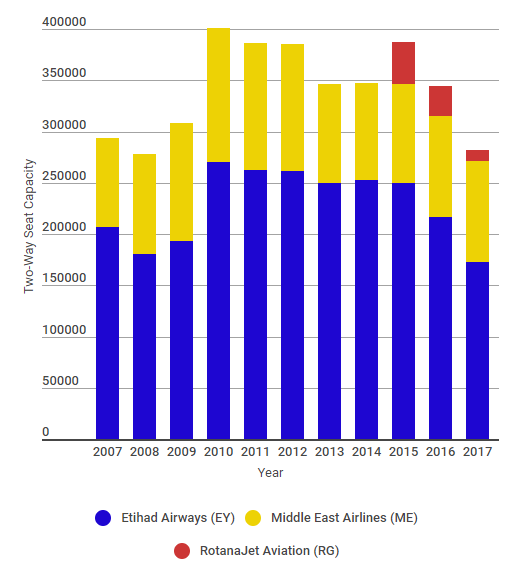The deployment of the two-class widebody from July 25, 2017 provides an increase of 125 seats per flight versus the Airbus A321 it replaces, with 4,186 weekly seats now offered in both directions, including a significant rise in the premium offering thanks to the 299-seat 787-9 being configured with 28 of its Business Studios alongside 271 Economy seats.
Beirut was actually the first international destination served by Etihad when it inaugurated operations back in 2003 and the airline now carries more than 150,000 passengers a year between the two cities, carrying more than one million passengers so far this decade, around two-thirds of the total segment demand.
Etihad's revised offering into Beirut is made possible by the recent arrival of a 16th 787-9 into the Etihad fleet. The airline has a further nine 787-9s on order as well as 30 larger 787-10s, according to the CAPA - Centre for Aviation fleet database with three more due in 2017 and four scheduled for delivery in 2018.
CHART - Etihad Airways Aircraft Delivery Pipeline (2017 - 2025) Source: CAPA - Centre for Aviation
Source: CAPA - Centre for Aviation
The capacity change reflects the strong demand between Lebanon and Abu Dhabi and the entire UAE, where there is a large Lebanese expatriate community. "Additionally, a significant proportion of our customers travelling to Lebanon originate in Australia, says Mohammad Al Bulooki, executive vice president commercial, Etihad Airways.
Demographic data shows there are more Lebanese living outside of Lebanon than within the country. As the smallest recognised nation on the Asian continent, located at the crossroads of the Mediterranean Basin and the Arabian hinterland, Lebanon is only 10,452 square kilometres in area and home to an estimated population of over six million. But, conservative estimates numbers its diaspora at over eight million, perhaps rising as high as 14 million.
The Lebanese diaspora has historically been trade-related, albeit more recently it has been linked to the Lebanese Civil War, and the pull from Arabia for labour reasons. The largest concentration of Lebanese outside the Middle East is in Brazil with sizeable populations in other parts of South America, notably Argentina and Venezuela, as well as further north into USA and Canada.
CHART - Geographical Distribution of the Lebanese Diaspora Source: iloubnan.info
Source: iloubnan.info
Australia is also home to a considerable Lebanese community. Between 270,000 and 350,000 people of Lebanese ancestry are estimated to reside in Australia with more than two thirds living around the Sydney area. This supports a market of more than 130,000 annual indirect passengers between the two countries, with more than a third connecting via Abu Dhabi with Etihad, according to data from OAG, the largest air corridor between the two countries.
Alongside the use of the larger aircraft, to meet peak season demand Etihad will also add four extra weekly frequencies to Beirut, between August 2, 2017 and September 10, 2017, operated by an Airbus A320 aircraft on Monday, Wednesday, Friday and Sunday. The route is also served by Middle East Airlines and up until this month by UAE carrier RotanaJet Aviation.
The positive news on the deployment of the 787-9 hides a much bigger story - a city pair market that has actually seen a significant cut in capacity over the past three years. In fact for a long time Etihad had previously deployed widebodied aircraft into the market in the form of the A330-200 before reverting to an exclusive single-aisle operation since October 2015. The UAE carrier's offering on the route this year is its lowest for more than ten years, with capacity down 20.2% on 2016 and down 35.9% since the start of the decade.
